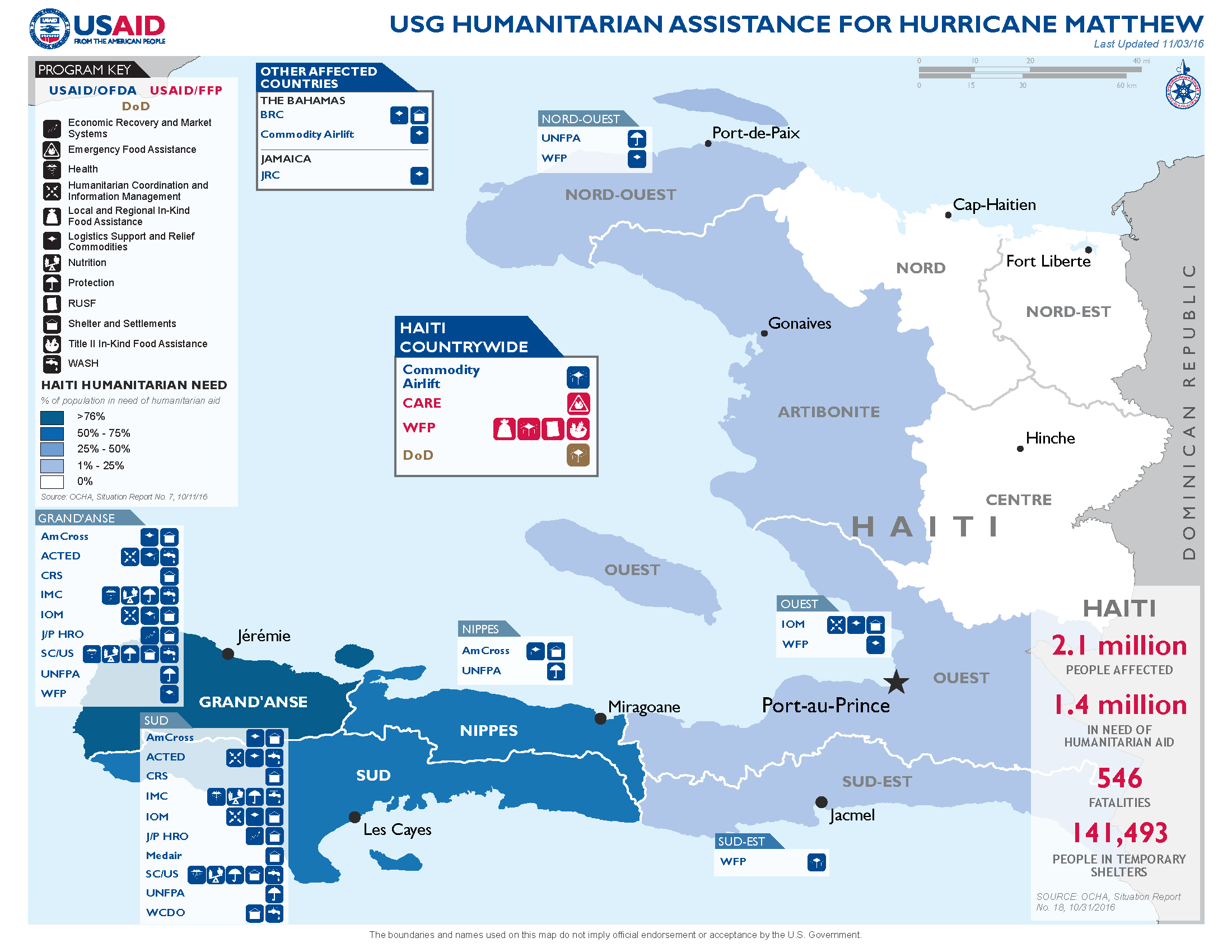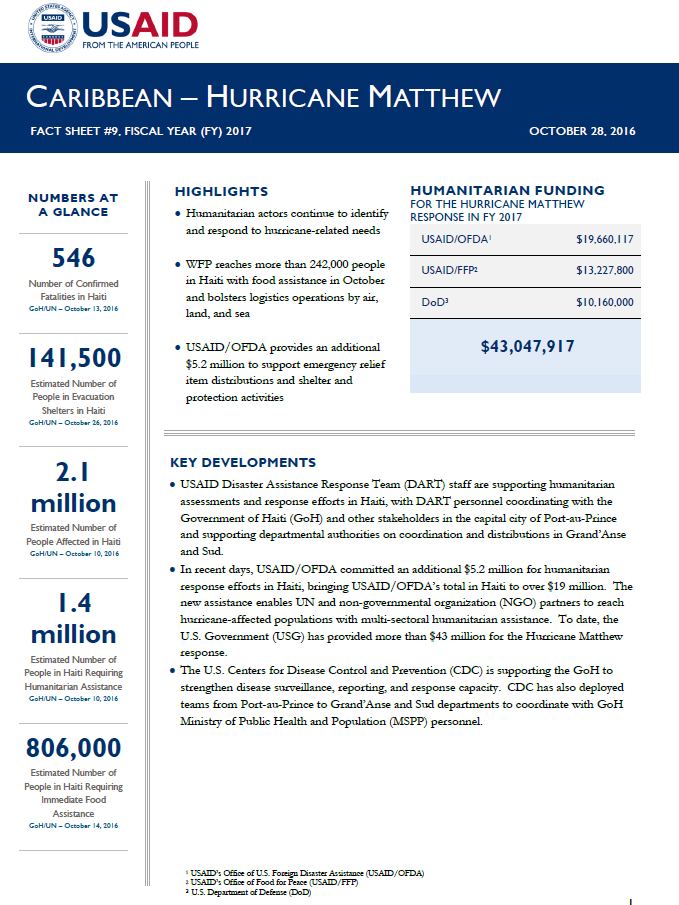November 3, 2016
Highlights
USAID/OFDA contributes more than $5 million in additional support for emergency relief activities in Haiti.
WFP bolsters logistics operations by air, land, and sea; reaches more than 350,000 people with food assistance in October.
USAID continues to work with humanitarian actors to respond to immediate shelter needs.
Key Developments
Numbers At A Glance
546
141,500
2.1 million
1.4 million
806,000
Humanitarian Funding
For the Hurricane Matthew Response
in FY 2017
| USAID/OFDA | $24,937,576 |
| USAID/FFP | $13,227,800 |
| DoD | $10,160,000 |
| TOTAL | $48,325,376 |
More than 141,000 people remain displaced in temporary shelters in Grand’Anse, Nippes, Ouest, and Sud departments, according to the UN Office for the Coordination of Humanitarian Affairs (OCHA). To enable the return of displaced households to their homes, USAID’s Disaster Assistance Response Team (DART) continues to work with the Government of Haiti (GoH) and humanitarian partners to distribute emergency shelter assistance and develop a longer-term shelter strategy in hurricane-affected areas.
USAID/OFDA has contributed more than $5 million in additional support for the Hurricane Matthew response in Haiti. With this additional funding, USAID/OFDA is supporting non-governmental organization partners to address health needs and ensure the continuity of health care services; ensure that vulnerable children and households are protected from abuse, exploitation, and violence; augment logistical, telecommunications, and transportation capacity; distribute emergency relief supplies and conduct water, sanitation, and hygiene (WASH) interventions; and address the immediate shelter needs of affected populations. Cumulatively, USAID has provided approximately $37.6 million in support for the Hurricane Matthew response in Haiti, making USAID the single largest donor of humanitarian assistance to the country in the aftermath of the hurricane.
USAID remains the largest donor to UN World Food Program (WFP) hurricane response operations in Haiti providing approximately $15.5 million. USAID funding to WFP includes approximately $10 million from USAID/FFP for emergency food assistance and $5.5 million from USAID/OFDA and USAID/FFP for WFP’s Special Operation, which seeks to bolster logistical, telecommunications, and transportation capacity in Haiti to facilitate the delivery of critical relief commodities to hard-hit communities.
FOOD ASSISTANCE
In response to a recent food security assessment indicating that approximately 806,000 people in Haiti require urgent food assistance, WFP plans to reach 800,000 people through general food distributions complemented by blanket supplementary feeding programs. The supplementary feeding is aimed at preventing acute malnutrition in children five years and younger and pregnant and lactating women through the provision of specialized nutrition products.
On October 31, WFP and the International Organization for Migration (IOM) conducted a joint distribution of food and relief supplies to more than 700 households in the Chateau neighborhood of Jeremie commune, Grand’Anse. Additionally, USAID/FFP partner CARE provided more than 800 hot meals to people in temporary shelters in Abricots commune, Grand’Anse, on October 28. To date CARE has provided nearly 85,600 hot meals, reaching 22,400 people, in Grand’Anse, Ouest, Sud, and Sud-Est departments, with USAID/FFP support.
On November 1, WFP distributed food assistance to nearly 1,240 households in Chateau, Jeremie, and nearly 820 households in Anse d’Hainault commune, Grand’Anse. In total, USAID partner WFP, in coordination with other food actors, distributed approximately 3,250 metric tons (MT) of food assistance to 350,000 people across Grand’Anse, Nippes, and Sud between October 8 and November 1.
HEALTH AND WASH
Between October 4 and 28, health actors reported approximately 4,200 suspected cholera cases in Haiti, according to the GoH Ministry of Health and Population (MSPP). The MSPP, in coordination with the Pan American Health Organization (PAHO) and the UN Children’s Fund (UNICEF), plans to launch an oral cholera vaccination campaign in early November, targeting approximately 900,000 people across nine of Sud’s communes and five of Grand’Anse’s communes. A second round of vaccinations is planned for February 2017.
USAID/OFDA continues to support International Medical Corps (IMC) to address urgent health and WASH needs in Grand’Anse and Sud. As of October 27, IMC mobile medical teams had provided 2,600 health consultations in affected communities and temporary shelters in the two departments. IMC teams are also conducting WASH interventions, such as cleaning and disinfecting latrines and repairing water systems, at four temporary shelters in Sud’s Les Cayes commune. As of October 27, IMC is treating 45 patients at a USAID/OFDA-supported cholera treatment facility in Sud’s Les Anglais commune, which opened on October 16.
On October 27, USAID/OFDA transferred 38.1 MT of calcium hypochlorite (HTH) — sufficient to meet the water treatment needs of all GoH-managed water systems in Haiti for three months—to an IOM warehouse in Haiti’s capital city of Port-au-Prince. IOM, in coordination with U.S. Centers for Disease Control and Prevention (CDC) advisors, will manage the distribution of the HTH to local water authorities throughout the country. CDC also plans to assist the GoH National Directorate for Water and Sanitation with WASH interventions, including through the distribution of USAID/OFDA-supplied water chlorination supplies.
USAID/OFDA is supporting PAHO to address urgent health needs and ensure the continuity of health care services by procuring and distributing essential cholera and critical health supplies to health facilities and mobilizing additional health care personnel to provide technical support to the departmental health directorates in Grand’Anse and Sud.
SHELTER AND RELIEF ITEMS
More than 141,000 people remained in 204 temporary shelters in Grand’Anse, Nippes, Ouest, and Sud as of October 31, OCHA reports. Approximately 15 percent of shelter residents comprise children ages five years and younger.
On November 1, the DART accompanied USAID/OFDA partner J/P Haitian Relief Organization (J/P HRO) to observe road conditions along the coastal route between Grand’Anse’s Jeremie and Dame-Marie communes. J/P HRO has successfully cleared obstructions on the coastal route, facilitating the delivery of critically-needed relief commodities to areas that had been cut off by the storm. During the trip, DART staff observed widespread self-recovery activities, with households using a combination of metal and plastic sheeting, as well as salvaged timber, to repair hurricane-related damages to houses.
On October 30, a commodity flight carrying 488 rolls of USAID/OFDA-procured plastic sheeting arrived in Haiti’s capital city of Port-au-Prince. The commodities were subsequently transferred to IOM for onward delivery to affected populations via its distributing partners.
With USAID/OFDA support, Mercy Corps is addressing the immediate shelter needs of hurricane-affected populations in western Nippes’s Anse-a-Veau and Petit-Trou-de-Nippes communes, which have been identified by the GoH Directorate of Civil Protection and departmental-level emergency operations center as priority areas for assistance. Mercy Corps is distributing emergency shelter kits, facilitating household-level training on how to most effectively use the supplied shelter materials, and overseeing repair efforts. The program aims to reach more than 19,000 people across the two communes.
USAID/OFDA is also supporting the American Red Cross (AmCross), CRS, J/P HRO, Medair, Save the Children/U.S. (SC/US), and the World Concern Development Organization (WCDO) to distribute shelter materials, including plastic sheeting and shelter repair toolkits, and assist households in making durable shelter repairs using supplied materials.
PROTECTION
An estimated 540,000 women and 125,000 children in hurricane-affected areas are in need of protection assistance, according to the UN. Additionally, the UN reports that approximately 3,500 children in institutions require nutritional and WASH assistance, as well as support to reconnect with family members. Prior to the hurricane, Grand’Anse had the highest rate of children in institutions, including orphanages, in Haiti.
The UN Population Fund (UNFPA) has expressed concern regarding the limited number of organizations providing protection and sexual and gender-based violence services in affected areas. UNFPA has also expressed concern that funding for protection services remains inadequate and has called on response actors to bolster protection activities in the worst-affected areas. As of late October, five humanitarian organizations were providing protection services to affected populations in Grand’Anse’s Abricots, Anse-d’Hainault, Beaumont, Bonbon, Jeremie, Pestel, and Roseaux communes, while four organizations were targeting vulnerable populations in Sud’s Aquin, Camp-Perrin, Cavaillon, Chantal, Coteaux, Les Anglais, and Les Cayes communes.
To strengthen capacity in health facilities and support the operations of two mobile clinics to provide health services to affected individuals in hard-to-reach areas, UNFPA is deploying teams of trained midwives to the Grand’Anse and Nippes departments. The UN agency also plans to provide more than 260 emergency reproductive health kits, reaching an estimated 390,000 people over the next three months with medical equipment, medicine, and other supplies for safe deliveries, rape treatment, and other health services. USAID/OFDA has provided more than $100,000 to support UNFPA’s protection interventions in Grand’Anse, Nippes, Nord-Ouest, and Sud departments.
USAID/OFDA is supporting UNICEF with $400,000 to ensure that vulnerable children and households in Grand’Anse are protected from abuse, exploitation, and violence by providing technical assistance and equipment to the GoH Ministry of Social Affairs and other relevant GoH actors, support to three operational child-friendly spaces, and assistance with community-based social work and case management services, among other activities. In addition, USAID/OFDA is supporting IMC to implement protection activities, including facilitating the creation of child-friendly spaces at temporary shelter sites, in Grand’Anse and Sud. IMC protection activities are targeting an estimated 2,500 people.
CONTEXT
Hurricane Matthew made initial landfall near Haiti’s Les Anglais commune, Sud, and secondary landfall over eastern Cuba on October 4 before continuing to traverse The Bahamas from October 5–7. The hurricane brought destructive winds, heavy rainfall, and dangerous storm surge, resulting in extensive damage to crops, houses, and infrastructure, as well as widespread flooding in some areas.
On October 2, U.S. Ambassador to Haiti Peter F. Mulrean and U.S. Chargé d’Affaires, a.i., for Jamaica Eric Khant issued disaster declarations in response to the anticipated effects of Hurricane Matthew. U.S. Chargé d’Affaires, a.i., Lisa A. Johnson issued a disaster declaration in response to the anticipated effects of Hurricane Matthew in The Bahamas on October 4.
USAID activated a regional DART on October 3 with staff in The Bahamas, Haiti, and Jamaica. USAID also stood up a Washington, D.C.-based Response Management Team to coordinate the regional humanitarian response.
Based on assessment findings and in consultation with government representatives in the two countries, USAID discontinued DART operations in Jamaica and The Bahamas on October 5 and 13, respectively. USAID/OFDA regional staff will continue to monitor USAID/OFDA assistance provided to the Bahamas Red Cross (BRC) and the Jamaica Red Cross (JRC) to address the immediate needs of populations affected by Hurricane Matthew.









Comment
Make a general inquiry or suggest an improvement.